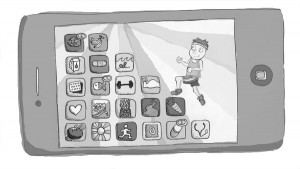Technology helps boost fitness, sexual health
Many health experts decry technology for encouraging a sedentary lifestyle. The phrase “couch potato” comes to mind.
But when used properly, technology can help people stay on top of their health.
Public health experts need to start using technology as a tool to help people be healthier, and people need to start using the resources they have at their fingertips.
There is no denying the role that technology plays in the obesity epidemic. A 2008 study using data from the Canadian Community Health Survey found that obesity is positively correlated with the amount of time spent in front of a television or computer screen each day.
Though technology tends to make going out and jogging less appealing, it can also give people the tools and information to get fit.
For example, calorie trackers help people monitor their food intake on a daily basis. While there is the appropriate time to indulge, it is also important to be aware of the calories you are consuming. Livestrong.com/MyPlate allows you to find out what’s in that piece of pizza you ate at your club meeting. Livestrong also allows you to monitor your fitness goals, your nutrient intake and your water intake.
If you’ve ever wondered how far the walk is from your apartment to campus, you can easily find out with the MapMyRun application or website. The application monitors your position and shows your pace, elevation, the distance covered and workout time. If you find a particular route you want to remember for later, you can save your workout. If you do not have a smartphone, you can always go on the website to manually log your workouts.
Technology isn’t just for meals and weekend runs. It can also improve your sex life.
The Internet can combat the dearth of safe-sex education in public schools. Many websites serve as resources for teenagers and young adults who are figuring out their sexual preferences and needs.
Information is now at the fingertips of women who are eager to learn more about their options for pregnancy prevention.
Bedsider.org is a clear, concise encyclopedia of all the birth control options available. It spells out the positive effects, the negative side effects, whether the method protects against STIs and where you can get these methods — some from a provider, some over the counter.
In addition, the website allows users to set up text or email reminders about doctors’ appointments and birth control usage.
Online resources aren’t limited to women. LuckyBloke.com provides a service for people who often find themselves without condoms when they really need them, or for people who are embarrassed about buying condoms at a store.
LuckyBloke allows you to create a custom package of condoms based on a large variety of brands, shapes, sizes and lubricants. A package arrives every month — so there’s no excuse not to have them around. Ten percent of profits go to charities such as It Gets Better and Clean Water.
Though phones, televisions and computers have the potential to promote a more sedentary and unhealthy lifestyle, some applications and websites can do quite the opposite. From ordering a personalized monthly supply of condoms to monitoring workouts, these tools can help promote your health.
Of course, they’re only tools. All the applications in the world won’t help unless you eventually step away from the couch.
Natalie Chau, Brooke Sanders and Lucas Griffin are peer health educators of the Office for Wellness and Health Promotion.


I have use MapMyRun app & use this app from my home to office. i very like this app